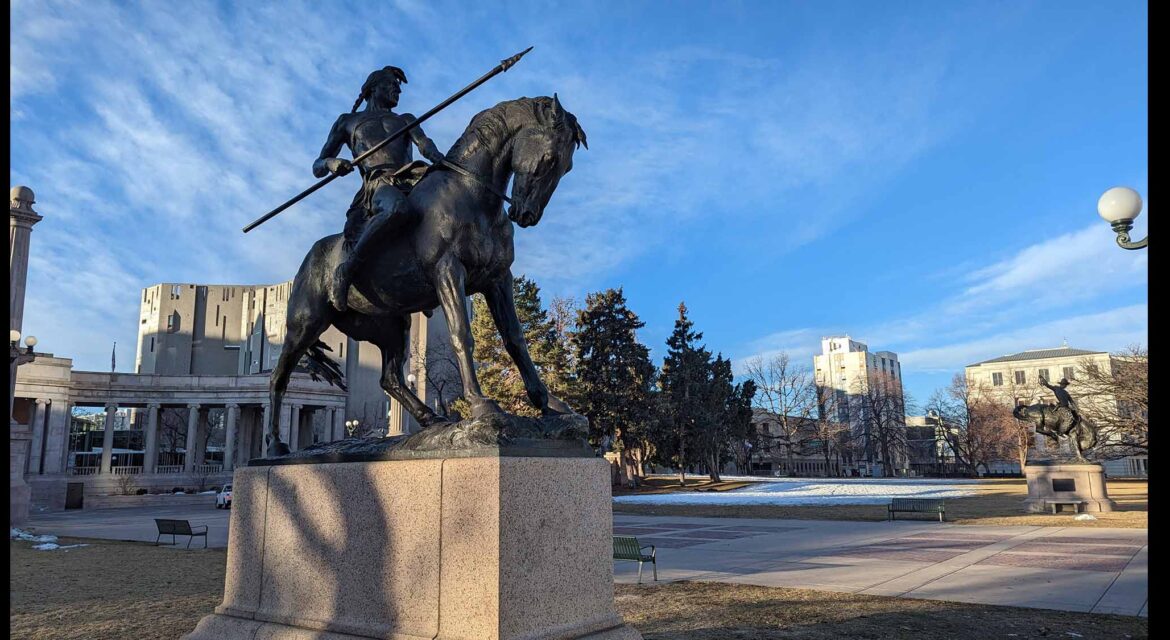 Civic Center Park is one of the most important landmarks in Denver, Colorado, but two statues that can be found in the park highlight how individual monuments can cultivate additional connections with audiences. The “Bronco Buster” and “On the War Trail” sculptures allow audiences to see and experience the history and legacy of Denver, becoming icons for the location and city that resonates with both residents and visitors.
Civic Center Park is one of the most important landmarks in Denver, Colorado, but two statues that can be found in the park highlight how individual monuments can cultivate additional connections with audiences. The “Bronco Buster” and “On the War Trail” sculptures allow audiences to see and experience the history and legacy of Denver, becoming icons for the location and city that resonates with both residents and visitors.

Two Monuments for the City
 Located near the west entrance of Civic Center Park, the “Bronco Buster” and “On the War Trail” sculptures were installed not long after the park was created in 1904. In 1917, Denver Mayor Robert Speer asked Alexander Phimster Proctor, one of the most notable sculptors of the era, to create two monuments for the city.
Located near the west entrance of Civic Center Park, the “Bronco Buster” and “On the War Trail” sculptures were installed not long after the park was created in 1904. In 1917, Denver Mayor Robert Speer asked Alexander Phimster Proctor, one of the most notable sculptors of the era, to create two monuments for the city.
The “Bronco Buster” sculpture shows a cowboy on a bucking bronco. Created to capture the legendary spirit of the Old West within Denver, the model was a real-life cowboy, Bill “Slim” Ridings, who was a popular Pendleton Round-Up rodeo rider. The sculpture was dedicated in 1920.
“On the War Trail” was dedicated in 1922 and is the second of the two statues by Proctor. Depicting an American Indian riding on a horse and holding a spear, the piece is Proctor’s tribute to the native people of Colorado. Models were Jackson Sundown of the Idaho Nez Pierce tribe, and Big Beaver of the Montana Blackfeet tribe.
By representing the history and culture of the city in such a profound way, both the “Bronco Buster” and “On the War Trail” sculptures have been embraced by the community as icons that are synonymous with Civic Center Park and Denver as a whole, highlighting the power of such pieces to make an impact that can be seen and felt across the eras.

History and Legacy of Denver
 Included on various maps and guides for Civic Center Park and even for the city of Denver, the “Bronco Buster” and “On the War Trail” sculptures have become recognizable icons that audiences are able to connect with in terms of the history and legacy they represent. That impact has ensured the sculptures will continue to serve as important attractions in the short and long term.
Included on various maps and guides for Civic Center Park and even for the city of Denver, the “Bronco Buster” and “On the War Trail” sculptures have become recognizable icons that audiences are able to connect with in terms of the history and legacy they represent. That impact has ensured the sculptures will continue to serve as important attractions in the short and long term.

